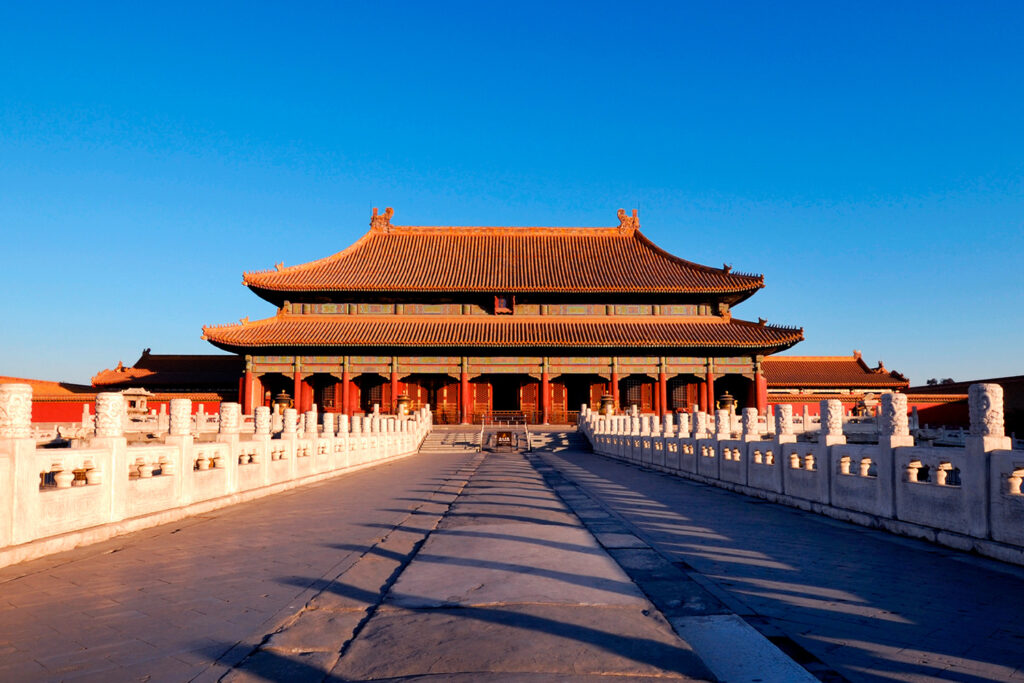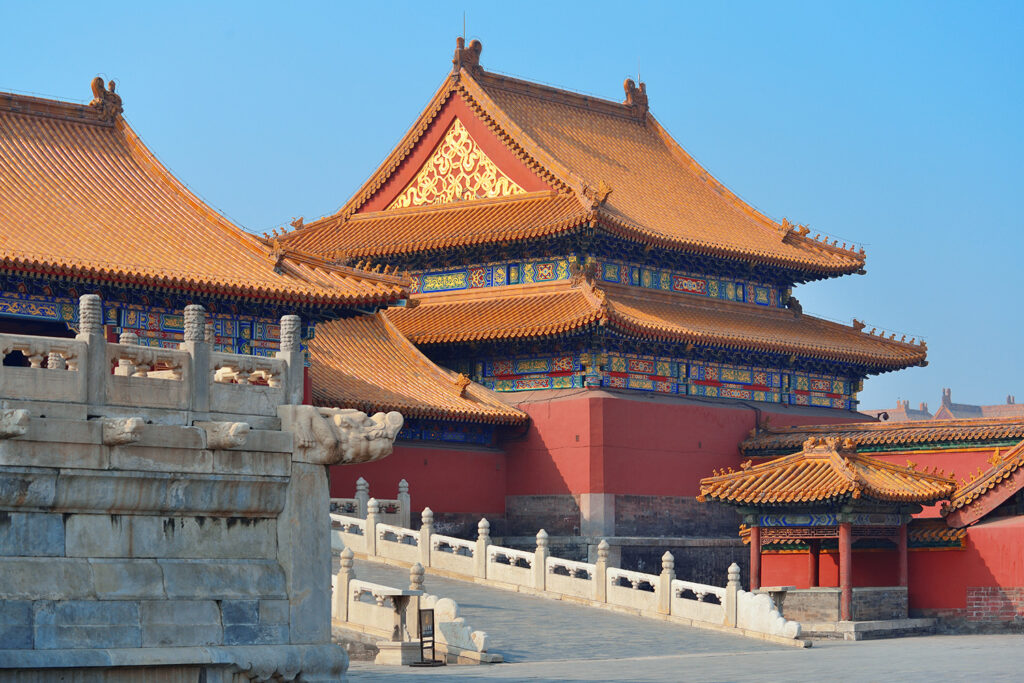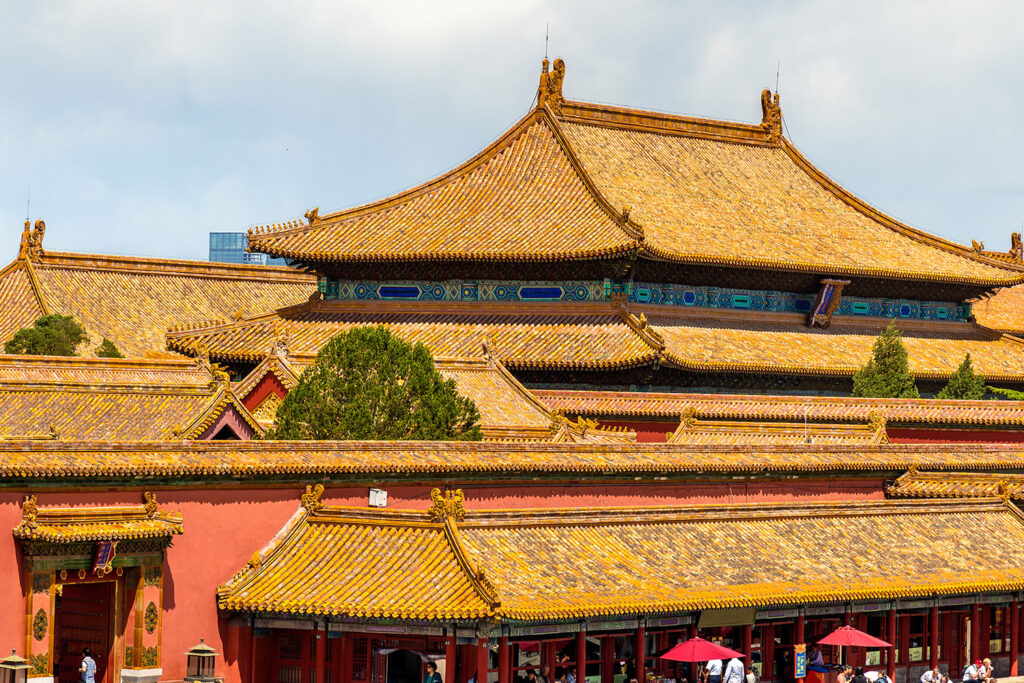This extraordinary palace complex was the setting for both the most significant state ceremonies and the private lives of Chinese emperors for centuries. Today, as a museum surrounded by imposing walls, it reveals the treasures of Chinese culture and unveils the secrets of two Chinese dynasties to successive generations.
Contrary to what its name might suggest, the Forbidden City in Beijing is neither a dangerous district nor an area restricted to a specific social group. It is a vast area in the heart of Beijing that resembles a self-contained city. While today it functions as the Palace Museum, during the Ming and Qing dynasties, it served as the residence of the emperor and the center of imperial family life. What makes this former home of 24 Chinese emperors so captivating to over 10 million tourists who visit it each year?
The History of the Imperial Residence
Perhaps today, no one would be admiring this historic palace complex in Beijing if it weren’t for Emperor Yongle of the Ming dynasty. It was he who, in 1406, ordered the construction of the palace, now known as the Forbidden City. The construction took 14 years and required about a million laborers to complete.
In creating this space, Yongle not only served himself but also the many emperors who followed him on the Chinese throne. Ming dynasty rulers resided in the Forbidden City until 1644. Soon after, China was plunged into civil war, during which much of the city’s structure was destroyed.
However, the Qing dynasty restored all the damages. They renovated the structures, changed many of the names, and introduced slight modifications, ensuring the palace complex served the next 10 emperors of the dynasty. The Forbidden City’s role as the residence of rulers and the political center of China ended in 1912, with the abdication of the last emperor. The outer part of the city was opened to the public immediately, but the Inner Court could only be viewed from 1924 onward. The following year, the official Palace Museum was established, and in 1987, the Forbidden City was listed as a UNESCO World Heritage Site.
Where did the name “Forbidden City” come from?

The mysterious name was actually given to the site by the Chinese people themselves. It was widely known that access to the palace complex was extremely restricted. Only the emperor, his family, and eunuchs – trusted guards – were allowed inside. Any unauthorized entry was severely punished, often by execution, which led most subjects to admire the palace structures from nearby hills. This exclusivity gave rise to the colloquial name “Forbidden City,” which stuck with the place for a long time.
Today, the Chinese commonly refer to it as Gù Gōng, which translates to “Former Palace” or “Ancient Palace.” However, the old term “Forbidden City” is still often heard, likely because of its intriguing appeal. If you tell someone who knows little about it that you’ve been to the Forbidden City, you’re likely to capture their full attention for quite some time.
FUN FACT: While today practically anyone can stroll among the buildings of the Forbidden City, a certain air of exclusivity still surrounds the site. Since 1949, when Mao Zedong declared the founding of the People’s Republic of China, only one foreign leader has had the honor of attending an official meeting within the Forbidden City: Donald Trump in 2017.
What does the former imperial palace look like?
The Forbidden City, the center of imperial rule in China, is a vast complex of buildings. To put its size into perspective, the distance between its northern and southern gates is nearly a kilometer. This mini-city is enclosed by defensive walls and a moat, and within its streets are nearly 1,000 palaces and pavilions. According to legend, the complex is said to contain exactly 9,999 rooms, though in reality, the number is slightly lower. Nevertheless, the room count is still in the thousands, and the majority of these spaces are now open to the public.

This impressive complex represents the largest wooden palace ensemble in the world. Every building was constructed following the principles of traditional Chinese architecture. Most of the structures are painted in red and gold—colors considered lucky in Chinese culture. Both the layout of the Forbidden City and the design of individual buildings reflect the deeply ingrained hierarchy of Chinese society. The significance of each building can be gauged not only by its size but also by the style of its roof and the number of decorative figurines adorning it.
Exploring the Forbidden City
The Forbidden City is vast enough that visitors can easily spend an entire day exploring its grounds. A full-day visit allows tourists to leisurely uncover every accessible corner of this historic complex, as well as enjoy traditional Chinese cuisine, sip coffee, and browse souvenir shops or bookstores—all without stepping outside its walls.
However, most visitors opt for the shorter route, which takes about two hours and follows the central north-south axis. While this brief tour doesn’t cover even half of the grounds, it does lead you past the most magnificent gates and palaces. You’ll begin by passing through the impressive southern Meridian Gate, which once served as the backdrop for imperial proclamations and appearances. Then, you’ll cross one of the bridges over the Golden Water River and, after walking across the first courtyard, you’ll enter the Gate of Supreme Harmony, which leads directly into the Outer Court.
The Outer Court
The Outer Court served as the administrative and ceremonial heart of the palace. Both state ceremonies and religious rituals took place in its courtyards and reception halls. The largest structure here is the Hall of Supreme Harmony. Decorated with intricate designs of golden dragons and roof figurines, this was the most important building in the palace. It’s where the emperor would sit on the throne during official ceremonies. Another key building in this part of the Forbidden City is the Hall of Preserving Harmony, which hosted events such as imperial weddings, end-of-year banquets, and moon festival celebrations.
The Inner Court

The Gate of Heavenly Purity marks the boundary between the ceremonial section of the Forbidden City and the private residence of the emperor and his family. Within the Inner Court, the most significant structures are the Palace of Heavenly Purity and the Palace of Earthly Tranquility. The Palace of Heavenly Purity served as the emperor’s residence and office until 1723. Although the imperial sleeping quarters were moved after that time, the palace continued to host routine governmental affairs and certain rituals. The Palace of Earthly Tranquility, on the other hand, was primarily the private residence of the empress.
The Imperial Garden
Typically, the last stop before exiting the Forbidden City is the serene Imperial Garden, designed as a peaceful retreat for the imperial family. Amid lush greenery, small ponds, and sculptures are several pavilions worth exploring. Here, visitors can discover spots where emperors composed poetry, the former imperial library, a Taoist temple, and a hall dedicated to Buddha worship.
The endless alleys of the Forbidden City
If you have more time to explore the Forbidden City, try stepping away from the crowded central axis. It’s worth visiting the northeastern corner of the complex, known as the Palace of Tranquil Longevity Sector. This area housed widowed empresses, retired emperors, and many imperial concubines. One of the highlights here is the striking Nine-Dragon Screen, a wall adorned with vibrant dragon motifs. And there are plenty more hidden gems like these throughout the maze of alleys in this vast historical site.
Galleries and temporary exhibitions
In addition to the palace buildings, the Forbidden City hosts temporary exhibitions, often focused on various aspects of Chinese art and culture. However, not all exhibits rotate regularly. There are permanent galleries such as the Furniture Gallery, which houses over 6,000 rare pieces of decor, the Sculpture Gallery, and the Gallery of Military Equipment. Some of these galleries, like the Hall of Clocks and the Treasure Gallery, require an additional fee. But the opportunity to see intricate clocks gifted to the Qing emperors by European leaders or stunning jade, pearl, and gold jewelry is worth the extra Chinese yuan.
Planning your visit to the Forbidden City
One key thing to remember when planning your visit to the Forbidden City is that tickets cannot be purchased on-site on the day of your visit. Tickets must be booked online in advance. During off-season, you may be able to reserve a day prior, but in the peak summer months, it can be tricky as there is a daily limit on the number of tickets sold. With an e-ticket, you only need to line up for security checks before entering the palace grounds.
Since many of the buildings in the Forbidden City may look quite similar, the best way to navigate (especially if you’re not on a guided tour) is with a map in hand. An audio guide can also be incredibly helpful in understanding the spaces you’re visiting. All available tickets can be found on GetYourGuide. Organized tours often combine a visit to the famous Tiananmen Square, which is located right next to the former palace grounds.
Practical information
- It is best to purchase tickets for the Forbidden City in advance. This way, you can avoid standing in long lines and reduce the risk of tickets being sold out.
- Address: 4 Jingshan Front St, Dongcheng, Beijing, China, 100009
- Buy tickets on GetYourGuide